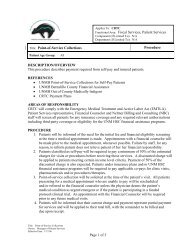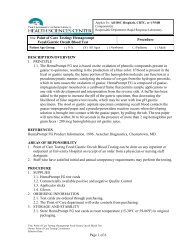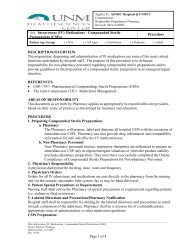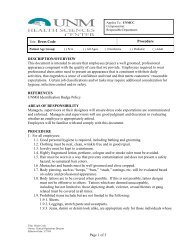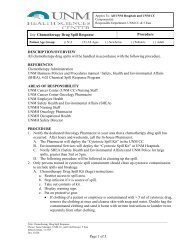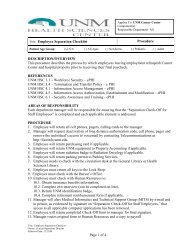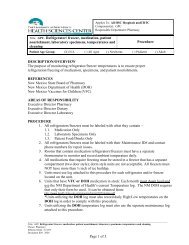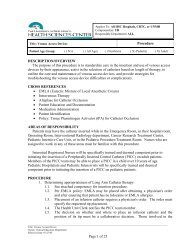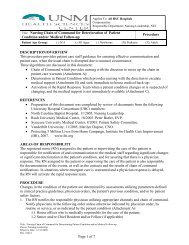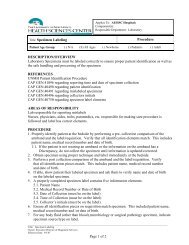Page 1 of 4 DESCRIPTION/OVERVIEW Intravenous (IV) therapy will ...
Page 1 of 4 DESCRIPTION/OVERVIEW Intravenous (IV) therapy will ...
Page 1 of 4 DESCRIPTION/OVERVIEW Intravenous (IV) therapy will ...
You also want an ePaper? Increase the reach of your titles
YUMPU automatically turns print PDFs into web optimized ePapers that Google loves.
3.4 Two large bore <strong>IV</strong>s <strong>of</strong> at least 18 gauge diameter in large veins are required forany emergency situation where large volumes <strong>of</strong> fluid and <strong>IV</strong> medicationsmight be required. The antecubital site is preferred. When the patient’s conditionis stabilized, the site should be changed if possible to a site not overlying a jointwith a smaller diameter catheter.3.5 If caustic agents are ordered or anticipated, a central line or a site on the proximalforearm is preferred. Do not choose a site over a joint if at all possible and avoidthe medial antecubital vein unless no other site is available. Caustic substancesshould not be infused through an <strong>IV</strong> located in the lower extremity. Consultpharmacy for a current list <strong>of</strong> caustic agents.3.6 In a cardiopulmonary emergency, vasoactive medications (including Dobutamine,Dopamine, Norepinephrine, Epinephrine and Esmolol) may be administeredperipherally, but central access should be established as soon as possible.4. Routine Care4.1 Standard precautions <strong>will</strong> be used when performing all aspects <strong>of</strong> <strong>IV</strong> <strong>therapy</strong>.Aseptic technique <strong>will</strong> be used for all venipunctures and dressing changes.4.2 Dressing changes should be done whenever the dressing becomes damp,loosened, soiled, or as needed.4.3 All patients on <strong>IV</strong> <strong>therapy</strong> should be monitored for intake and output (I&O).4.4 All <strong>IV</strong> bottles/bags should be changed at least every 24 hours. All cassettes andtubing should be changed every 72 hours, with the following exceptions:4.4.1 Intralipid, Total Parenteral Nutrition (TPN), Peripheral ParenteralNutrition (PPN), dextrose solution 10%, and tubing <strong>of</strong> thesesolutions must be changed every 24 hours. TPN and PPN filters<strong>will</strong> be replaced with tubing change.4.4.2 Pressure line tubing (arterial, central venous pressure, pulmonaryartery catheter)and flush solution should be changed every 96hours.4.4.3 All bottles/bags and tubings must be labeled with date and timehung.4.5 Peripheral <strong>IV</strong>s4.5.1 Change sites every 96 hours or as needed. If no alternative site isavailable, it is possible to get one twenty-four hour extension <strong>of</strong> the<strong>IV</strong> site if the current site is patent, intact, and exhibiting no signs orsymptoms <strong>of</strong> infection, phlebitis, or infiltration. An LIP order mustbe obtained for the <strong>IV</strong> site extension, and the reason for extensiondocumented in the nursing notes.4.5.2 Peripheral <strong>IV</strong> sites <strong>will</strong> be assessed at least every four hours foradult patients, and every two hours in pediatrics. The LIP <strong>will</strong> benotified if signs/symptoms <strong>of</strong> infection, infiltration, or phlebitis arepresent.4.6 Saline Locks4.6.1 A saline lock is an angiocath in a cannulated vein that is capped <strong>of</strong>ffor intermittent venous access.4.6.2 Site assessments must be documented q 1 hour while medication isinfusing.4.6.3 When the saline lock is not in use, flush q 6-8 hours with normalsaline flush. Refer to unit specific requirements for documentation._________________________________________________________________________________________________________________Title: <strong>Intravenous</strong> TherapyOwner: Nursing Practice CouncilEffective Date: 7/7/2010Doc. # 2636<strong>Page</strong> 2 <strong>of</strong> 4



